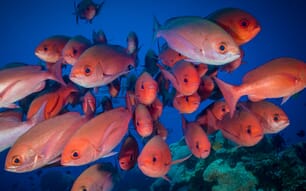Unagi, or freshwater eel, is a big hit during the summer in Japan but its popularity comes at a cost - its price has been rising, as overfishing and pollution have caused stocks to decline. The situation has become so serious that the species is now on the IUCN (International Union for Conservation of Nature and Natural Resources) red list of endangered species.
"It's undoubtedly a huge problem," said Ariji. "Many eel farmers told me that their businesses were affected, and asked if there was a way to cultivate a new species that could prove just as popular as eel."
Ariji is the leader of a research team at Kinki University who recently came up with a possible solution to the problem of declining eel stocks: catfish that taste like eel.
Because of its unpleasant mud-like smell, catfish isn't a popular choice of food for Japanese people. But it can be farmed in facilities that cultivate eel, and Ariji also discovered that its smell came from bacteria in river water and could be removed through proper cultivation. He began working with eel farming company Makihara Youman in Kagoshima Prefecture to create a catfish with the same taste and texture as eel. His method was to find the best combination of feed that would make the catfish meat juicy and give it a better taste.
Ariji's first sample was produced in February of this year. Although it didn't have a strong smell, salmon feed had made it slightly oily so he worked on creating different feed combinations and produced another sample for testing in September. He also compared varieties of catfish from across Japan and studied their smell and fat content, in order to select the best kind that could be cooked in the "kabayaki" style, a method in which eel is dipped in sweet soy sauce before being broiled on a grill.
"Feed and pellet production are big in Japanese aquaculture," Ariji explained. "I mixed different feed together like coffee beans. I tried salmon feed, yellowtail feed and even feed for sea bream. Each feed has a different content and I checked everything, from protein to fat to oil before producing a range of combinations. Some combinations contained 50% salmon feed, others had 20% yellowtail feed...I created a huge variety. The eel-like taste was very difficult to create, and I ate many samples of raw catfish to see whether we were making progress."
High quality solid feeds that are rich in nutrients are used widely in Japan to culture saltwater fish. Ariji asked Makihara Youman to raise the catfish on saltwater fish feed that is rich in fats and oils, instead of conventional feed for freshwater fish. In addition to oil and fat content, he also wanted to include enough protein and turned to other feed alternatives like shrimp and other crustaceans that have high amounts of collagen and give catfish meat a good structure and texture.
When the team cooked the catfish they'd raised, they found that the meat had more fat than conventional catfish.
"In fact, it was just like eel!" Ariji said.
But there were some challenges during the process.
"Coming up with the best taste was our greatest challenge," Ariji explained.
"Discovering how to get rid of that strong distinctive smell was hard so I checked catfish samples from areas such as Lake Biwa where water conditions are good, and the Yamato River in Nara Prefecture where the water conditions are bad. It really was a bit of trial and error. We kept mixing different feed and checking different samples until we'd found the right one. We were also able to reduce the smell considerably by using groundwater to farm the fish."
Another challenge, Ariji says, is that selling the catfish depends on whether large markets can be developed but he remains optimistic, saying that catfish can be completely farm-raised and if commercialised, would be available for half the price of eel, ideally around 500yen (£2.70).
During a recent Catfish Festival in Hashima city, Gifu Prefecture this October, attendees tried a small supply of eel-tasting catfish before its release for public consumption. The festival is an annual event to celebrate Hashima's tradition of eating river fish.
"We had 400 samples available over two days," Ariji explained. "All of them were gone in an hour as many people wanted to try them. We had 30,000 people lining up on the first day. Luckily, they enjoyed what they got!"
Ariji also believes it is possible to market his catfish in other parts of Japan. Twenty areas across the country have expressed an interest, as well as companies in the US who believe there is a big eel market there. Ariji hopes to produce more of the catfish in his own company so he can eventually export to other areas such as Europe. Spawning and producing broodstock is another important part of the process, and Ariji is aiming to turn this into an industry to provide more job opportunities, sustain existing farmers and, of course, increase the amount of eel-tasting catfish he produces.
"Our work has only just begun, and now we produce very little, but hopefully by next year, we'll be producing 100 or 200 tons a year," said Ariji, who is aiming to hold more promotional events to spread the word, and is positive that even further progress will be made. We'll be checking back to see how he fares.




